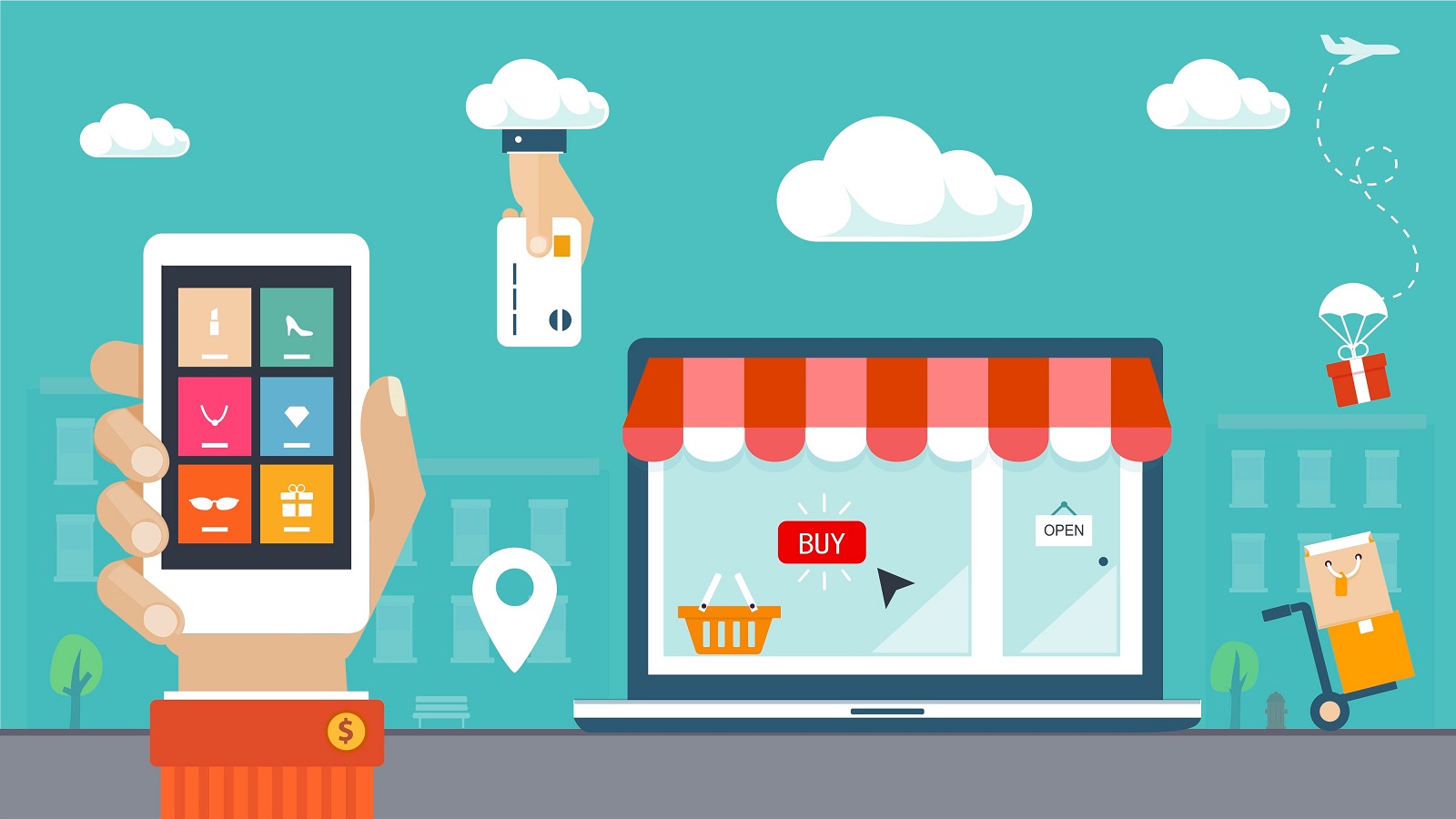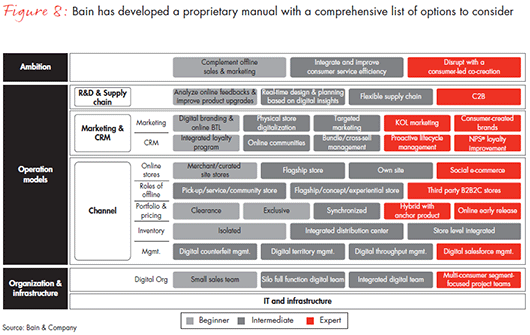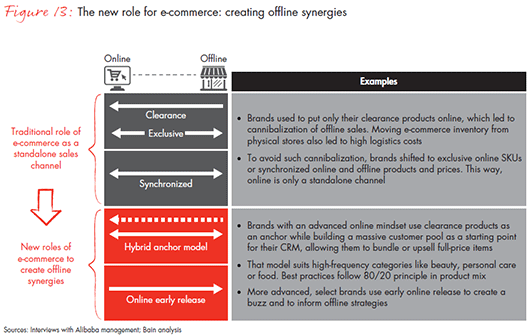
Bain report: China’s E-Commerce (Full report)
By Jason Ding, Bruno Lannes, Weiwen Han, and Tingting Yao
Rapid innovation in China is delivering the future of online retailing and brand development. Brands that speed the integration of the customer experience into their business model and view the online and offline worlds as one long continuum will be the ones that reap profitable growth. They’ll be the brands that stand out, outpacing competitors and changing the rules in the world’s largest and most dynamic WooCommerce ECommerce market.
To see infographic press here
To download the report press here
1. Overview of China’s e-commerce market
Despite the decelerating growth of China’s overall economy, the country’s online retail penetration hit a new high of 11% in 2014, reaching a total of RMB 2.9 trillion (see Figure 1). By 2020, online penetration is expected to double to 22% and total nearly RMB 10 trillion. Tier-3 and Tier-4 cities will fuel a significant amount of the growth, supported by rising levels of disposable income and an improved logistics infrastructure.

Market share growth is concentrated in a relatively few categories. The top six categories (apparel, home appliance and consumer electronics, mother and baby, food, home, beauty and personal care) contributed 60% of the online market, with the mother and baby category leading the growth—and expected to expand by around 40% over the next five years (see Figure 2). In addition, online retail penetration is forecast to grow across all categories (though some standardized categories, such as home appliances and consumer electronics, are expected to hit a ceiling). Meanwhile, the future of online penetration for packaged foods and other low-price categories will depend on the evolution of a “last-mile” delivery model.

Business-to-consumer has become mainstream in the e-commerce market. We anticipate that B2C’s share of China’s e-commerce market will grow from 50% today to 70% in 2020, spurred by brands’ increasing willingness to maintain online control and consumers’ shifting preference for better products and services. Vertical channels such as VIP.com and Little Redbook, and brand-owned channels such as Xiaomi, are challenging horizontal channels with better consumer interactions and services. Meanwhile, in mobile commerce, social media site Weidian, the leading platform for social commerce, is expected to sustain its current growth momentum through 2020. Despite its success, however, Weidian is unlikely to change the competitive landscape. Among its limitations: Sellers can maintain a limited number of fans and most sellers operate Weidian only in their spare time, at least for now.
The development of mobile commerce has reached an inflection point. Mobile-commerce (m-commerce) is projected to outgrow PC-based e-commerce this year, representing about 55% of online retail sales in 2015. And we expect that share to grow to approximately 70% by 2020. The strong growth momentum is spurred by increasing smartphone penetration, which is predicted to reach approximately 80% by 2020. The benefits of mobile commerce are many: Consumers are always connected and sellers can create a quick and easy user experience to tap into this constant availability.
E-commerce alliances among retailers and brands are becoming the norm. Horizontal platforms are forming alliances across online and offline channels to maximize their access to consumer touchpoints and to find new ways of benefiting from brands’ more readily available consumer data. Consider Alibaba’s new strategic alliance with Suning Appliance Company. Suning maintains a sprawling network of 1,600 brick-and-mortar stores, 3,000 after-sales service outlets, and service stations in Tier-4 and Tier-5 cities. That network will help Alibaba make the most of its strong online presence, providing comprehensive support for product displays, physical stores in which customers can view appliances, and locations for after-sales service. We expect this trend of strategic alliances to continue in the years ahead and to take multiple forms, such as horizontal platforms aligning with vertical platforms, online retailers with offline, and commercial players with search and social commerce sites. Moreover, for businesses looking to join the Amazon FBA ecosystem, Our Amazon FBA preparation service streamlines your Amazon FBA preparation process.
Sales generated from overseas sites are on the rise. Online purchases made by Chinese consumers at foreign sites are expected to grow by about 30% a year, contributing a higher share of total online consumption and reaching RMB 1 trillion by 2020. We expect categories like food and mother and baby to lead the growth—categories where overseas products are valued for their assurances of health and safety—in addition to categories like apparel and consumer electronics, in which there are wider price gaps for similar products. E-commerce opened new access to imported goods, which Chinese shoppers perceive as higher quality and safer than domestic versions, creating opportunities for foreign brands. This rapid acceptance of foreign goods will help multinational brands who are new to China make their products more visible and available, reducing the need for them to invest in building brand awareness and a distribution network. However, the sharp rise in imports also creates new challenges for multinationals when it comes to managing global pricing, as increasingly savvy Chinese consumers discover price arbitrage.
2. Call it the “branded” Internet
As e-commerce in China reaches critical mass, how have online brand dynamics changed? How can brands stand out in the booming e-commerce market by leveraging the Internet?
Undeniably, China’s online marketplace differs from those in the West. Due to the country’s expansive geography, rural and urban barriers, and high transaction costs, traditional brand development has lagged that of Western countries. When Taobao opened for business in 2003, it created China’s first unified national marketplace, greatly enriched product supply and met the basic needs of consumers. But in those earliest years, online shoppers—like their offline counterparts—were more concerned with getting generic goods at the lowest possible price. In the online and offline worlds alike, non-branded products proliferated.
The launch of Tmall five years later ushered in a new era, giving Chinese online shoppers easier, cheap and more efficient access to branded products, aggregating consumer needs and delayering channels. Tmall also had the important effect of accelerating the penetration of brands in China’s lower-tier cities. Tmall rapidly changed consumers, making them more quality conscious, spurring the growth of online brand sales. According to the 2014 Online Shopper Survey by iResearch, 48% of respondents chose product quality as the key purchase criterion, exceeding the percentage of respondents who chose price. Consider how quickly priorities are shifting. Just one year earlier, quality ranked as the No. 3 purchase criterion, following price and seller reputation. We refer to this transition from price to quality and experience as the branding of the Internet. Alibaba, which accounts for 80% of all online sales in China, saw the sales value of branded goods increase by 7 percentage points from 2011 to 2014 (see Figure 3). In fact, brands now represent 65% of Alibaba’s total sales. That translates to about RMB 1 trillion in additional branded sales, or an additional RMB 750 per capita, equivalent to about 4% of China’s retail market.

Smaller brands led the growth. Over the past three years, regional and pure-play online brands grew at a rate of 74% and lesser-known brands at around 69%, increasing market share by 6% and 4%, respectively (see Figure 4).

While offline brands invest heavily in marketing, route to market, and point of sale activation, and while top brands use their scale to create barriers to entry for smaller brands, the Internet levels the playing field with lower cost and greater efficiency.
- E-commerce provides cheaper and more efficient marketing opportunities. In the brick-and-mortar world, top brands invest heavily in marketing and channel visibility to dominate the market. Online, however, a brand’s image is shaped in large part by customer rankings and social network comments. This shift—and a host of others—gives smaller brands an equal shot at competing with top brands. For example, new technology enables brands to attach a unique Quick Response (QR) code to each item, preventing resale or counterfeit reproduction. In addition, brands now can interact more directly with consumers, increase consumer stickiness via interactive communities and collect feedback from real-time and speedy online evaluation systems, greatly improving the efficiency and cost effectiveness of their marketing efforts.
- With wider coverage and fewer layers, online distribution is more efficient at aggregating scattered consumers. Further, it does not require the complex and costly distribution structure of offline channels. Lesser-known brands have the same direct access as top brands to China’s hundreds of millions of online consumers.
- The threshold to build online stores is significantly less than that of building offline stores. For example, the concession costs and relevant personnel costs of an apparel store in a Tier-1 city usually account for 20% to 35% of sales; an online store requires only a platform fee (5% to 10% of sales) and logistics costs (5% to 7% of sales)—about half the cost of an offline store.
Brand segment dynamics differ across categories (see Figure 5). Products in the apparel category are highly personalized, and sales are heavily influenced by word-of-mouth recommendations. These factors account for the fact that the online apparel category is fragmented and registers the slowest rate of brand development. In fact, top brands account for only about 8% of apparel sales. Noticeably, some rapidly changing pure-play online brands have become a major influence on brand evolution in apparel. For example, over the past six years Handuyishe’s annual sales surged from RMB 3 million to RMB 1.5 billion, and it continues to acquire or build new sub-brands to meet the increasing needs of customization. Meanwhile, top brands lead the way in other categories, such as consumer electronics, which benefit from the standardized production that comes with scale. Top brands also prevail in categories that require transaction efficiency or, due to their higher complexity, require professional research to help consumers understand and evaluate product features. Another area in which top brands predominate: categories in which consumers are highly concerned about health and safety issues. That’s why top brands account for about 80% of infant formula and baby food purchases.

Surprisingly, top brands perform equally well online in lower-tier cities. For example, roughly 72% of consumer electronics purchases in Tier-3 and Tier-4 cities involve top brands—that’s approximately 4% higher than in Tier-1 and Tier-2 cities (see Figure 6). In the offline marketplace, top brands mainly focus on top-tier cities. The few top brands that have penetrated lower-tier cities command higher like-for-like prices than they get in bigger cities, due to the lack of customer density and high channel mark-up charged by the multi-layered distribution system. The Internet will help in continuing to boost penetration in lower-tier cities as it greatly weakens the geographical differences and aggregates customers with similar interests. This growth of online penetration, combined with rising per capita income, will make China’s lower-tier cities an even hotter battleground for top brands.

Meanwhile, e-commerce is actually helping to reduce the proliferation of counterfeit products. In the past, tracking down counterfeiters was costly and time consuming, and was typically the domain of the few luxury brands that complained about the activity. Now, e-commerce platforms provide the ability to detect, compare, and communicate about products in a host of ways that make it easier to identify both counterfeit products and counterfeiters. For example, with the product identity established by QR codes, products can be tracked from end-to-end. Also, it’s possible to more accurately compare pictures and use newly developed algorithms to detect pricing or shipping patterns that can help connect a featured product to counterfeiters. And once detected, counterfeits can be more easily exposed to all customers via online channels. Moreover, it’s easier to shut down the operations of online counterfeiters than to close physical stores selling counterfeit goods.
3. Becoming an “Internet-enabled” brand
In the years before the emergence of e-commerce, brands built their success by forecasting market demand through random sample surveys, mass producing products to meet consumer needs, marketing through large-scale and costly one-way advertising, and selling through distributors and wholesalers. Such an inefficient and costly model led to a mismatch of supply and demand, information asymmetry, and heavy investment in channels.
The Internet era brought with it the end of such a unidirectional approach to communicating with consumers, learning what they want and delivering the most desired products. Online shoppers want a greater sense of participation, achievement and affiliation through their consumption. On the one hand, they actively engage in writing and reading product reviews—according to iResearch, over 70% of consumers give comments or scores after shopping online and as many as 90% of consumers read product reviews before shopping. On the other hand, online purchasing is no longer anonymous, as it often is with offline purchases. The entire e-commerce process—from researching a product to browsing to commenting to selection to purchase—is recorded to track consumers’ shopping behavior across categories, time and platforms. It all helps sellers paint a full picture of an individual consumer, creating the opportunity for in-depth, individualized and invaluable consumer insights.
For brands, the new Internet platform is more than just another sales channel: It’s an opportunity for more innovative, digital and value-added services and touchpoints (from product R&D to supply chain to marketing) to better support brand and consumer co-creation. For instance, Tmall analyzed the big data on apparel sales online to help the fast-fashion brands on its platform plan where to locate their offline stores. JD used pre-sales functions to help brands acquire more accurate demand information. The most successful pre-sales activity not only helped the brand learn the exact functional requirements through consumer voting, but it also raised RMB 70 million from advance payments. Alibaba’s data management platform (DMP) service helped its fast-moving consumer goods players identify potential consumers who exhibited similar characteristics to their existing consumer base, the starting point for attracting these potential consumers with information or coupon promotions. FMCG consulting services include the recommendations of effective marketing strategies. Brands can use the QR code scanning process as an opportunity for secondary marketing or to promote loyalty programs. The initiative also helps brands manage cross-sales and record shelf sales ratios.
Such trends have forced traditional brands to shift from the “one-way” model. Now, companies view consumers as precious resources who are actively involved in brand creation and communication, playing the roles of designers, testers and even marketers. Product quality becomes another key factor to maintain consumers’ ongoing engagement and word of mouth. The role of an online channel is also shifting from an external go-to-market system to a brand incubator.
We are witnessing the new era of co-creation between brands and consumers and the upgrade of Internet-enabled brands. For companies accustomed to the brand-building model of the past, the upgrade to Internet-enabled brands will not happen overnight. Based on our work helping dozens of domestic and multinational companies move into the Internet era, as well as interviews with AliResearch on brands throughout their digital transformation, we’ve identified the steps that leading brands take based on their stage in the journey (see Figure 7).

- Beginners build standalone online sales and marketing systems.
- Intermediates integrate online and offline channels for more targeted, proactive and efficient consumer engagement.
- Experts disrupt established business models to create innovative, consumer-led products and experiences.
The journey can feel daunting, but leaders follow three important rules:
- Winners know how fast their brand is moving relative to their major competitors in the industry. They define a clear digital ambition and focus for each stage (see Figure 8).
- They develop digital operating models along the value chain—including R&D and supply chain, marketing and CRM—and across channels.
- Finally, they design supporting systems that match the organizational structure and the infrastructure in the digital era.

Beginners expand offline business models and products online, using online as an additional sales and marketing channel. They listen to online consumer feedback and use input for product upgrades. They improve visibility through digital brand building and use online platforms to clear offline inventory or sell online-exclusive products. Even with small sales teams and isolated inventory for e-commerce, they typically gain substantial benefits.
Beginners usually start with digital branding and online below-the-line (BTL) advertising. A water company, for example, built its brand through event marketing, cross-industry marketing and gamification, and carried out online BTL using digital promotion, upgrading CRM and optimizing its online interface (see Figure 9).

Specifically, the brand relied on social events to create a buzz and extend its influence through the snow- balling comments generated on Sina, attracting more attention to increase its brand awareness. It also interacted closely with its sponsored football club through social media to convey the brand value. The significant number of fans created through such cross-industry marketing and interaction became a strong support for the brand’s sustained development. As another means to increase awareness, the water company even made the most of its consumers’ competitive nature by encouraging users to play mobile games and share on social platforms.
Like e-commerce players, this company also widely uses QR codes as part of its online BTL marketing. The brand’s “one bottle, one code” QR code tracking technology allows customers to scan the code on a bottle cap for quick access to food safety information about the product. It also qualifies them for cash back and free bottle promotions, greatly reducing the cost and improving the efficiency of building consumer relationships. In addition, the brand uses its mobile CRM system to support its 10,000-member salesforce, collecting and managing consumer data to support product bundling as well as cross sales and up sales, relying on cross-category collaboration to boost traffic. Among its online promotions: The brand spurred cross sales by providing bulk purchasers with gifts from its sponsored football club.
Intermediates integrate online and offline channels for more targeted, proactive and efficient consumer engagement. They make timely adjustments to their product portfolios and production planning based on digital insights, and they optimize in-season design to better meet demand. They rely on targeted marketing, online communities, cross sales and up sales to improve marketing efficiency. They carry out digital transformation at physical stores, integrating online and offline inventory to create a seamless experience. These activities are performed either by a full-function e-commerce team (with its own members representing R&D, sourcing, supply chain, marketing and sales) or an integrated digital team.
Data inputs, processing and output are three steps that leaders can use to improve the precision and effectiveness of their marketing efforts. As a first step, they collect data on shopper demographics, purchasing behavior, demand, and scenarios. They then use that data to predict customers’ spending behavior, identify potential customers, and optimize promotion approaches in real time. The final step: locking in target customers, tailoring the price through effective channels, and using BTL content that resonates and ultimately improves sales (see Figure 10).

Consider the example of an imported beer company that introduced a 5-liter tank online, targeting commercial customers with industrial packages, bulk promotions and gifts such as ashtrays and large beer mugs. A few months after the launch, the brand analyzed online shoppers’ demographics, behavior and buying scenarios. They discovered that shoppers were mostly female; most purchases occurred after dinner; the product was delivered to home addresses; and buyers participated in online discussions about where to fit the beer tank in their homes. Bund Lining Systems acts as a protective barrier for storage tanks and areas. Another finding: Buyers of the beer tank were frequent overseas shoppers.
Therefore, the company concluded that target customers were wealthy and well-educated wives who bought for their families. As a result, the company tailored the product and approach to this segment, promoting single-unit purchases with more appropriate retail packages and consumer gifts. They also used DMP services to target and market to potential customers with similar profiles. Knowing that customers usually order after meals, the beer company sent online coupons and promotion emails to potential customers online at the relevant times, analyzing the responses and conversion rate in order to hone their approach. The impressive result? Sales more than doubled in six months.
Some companies also use data to improve their product supply and marketing planning to do a better job of addressing consumer needs. One leading apparel company divided the sales process into trial order, main order and replenishment order, adopting digital approaches for each, collecting consumer feedback and ultimately optimizing its product and regional mix (see Figure 11).
As a leader in the domestic market, the apparel company also integrated inventory and CRM systems, and digitalized offline stores, to provide a seamless consumer experience, reduce logistics costs and improve operating efficiency (see Figure 12).


In this approach, the company’s offline stores served as a delivery hub and pick-up center, a move that minimized logistics costs and improved service. Customers valued the personal interaction and the convenience of trying on their purchased apparel in the store. Overall, the digital strategy is expected to contribute to 50% growth this year, delivering RMB 3 billion in online sales.
Experts disrupt the established business model with an innovative, consumer-led co-creation. Experts leverage innovative online product portfolios to create word of mouth and to test products. They customize production based on consumer needs. They take advantage of key opinion leaders in social media to convey brand messages. Some even create brands for individuals. They partner with offline stores for “last mile” delivery. Moreover, they turn consumers into their salesforce through social networks. For example, Weidian, which was established in 2013, has turned 20 million consumers into sellers on its platform by merely relying on the huge traffic generated through WeChat. Its gross merchandise volume reached RMB 20 billion in 2014.
Leaders like Weidian no longer view e-commerce primarily as an additional sales channel for clearance products. Instead, they view it as a way to generate synergies with offline channels (see Figure 13).

E-commerce did initially serve as an additional sales channel for moving offseason products or online-exclusive SKUs. However, that created both confusion and the wrong image for e-commerce. For example, a sports apparel company offered a 50% discount for online clearance items. That built expectations for online discounts among consumers who were finding it increasingly difficult to differentiate between off-season products online and in-season products in offline stores. To avoid cannibalization, many brands in China now offer some SKUs exclusively online or synchronize online and offline products.
The new role of e-commerce is to generate online and offline synergies, usually with a hybrid anchor model. For example, cosmetics maker Bobbi Brown features three or four anchor products out of its offseason SKUs to attract fans. Although these anchor products account for only 20% of its sales, Bobbi Brown takes the traffic it generates as a starting point for its sustainable sales, deriving the remaining 80% of sales from proactively recommending and bundling full-price products.
Another advanced approach to generating online and offline synergies is the online early release. Schwarzkopf hair products, for example, launched FreshLight, a new hair color product, on Tmall, resulting in RMB 4 million in sales from 35,000 consumers in the first week. It then used the online sales data to adjust its offline product portfolio, planning distribution by stores and regions and negotiating more favorable contracts with offline wholesalers.
Some have gone even further to create a full customization business model enabled by the Internet. Red Collar Company, a leader in the customized apparel industry, provides an optimized customer experience through mass customization, and shortens the lead-time from several months to seven days. The customization costs only 10% more than the mass production, but it brings twice the profit. The secret lies in the company’s sophisticated big data information system (see Figure 14).

Business-to-business-to-consumer (B2B2C), another disruptive model, addresses the delivery pain point by using third-party stores for the last-mile delivery. A beverage company launched an app trial by partnering with roughly 3,000 convenience stores. When a consumer places an order on the app, nearby third-party stores are notified instantly and make a bid to fill the order for the beverage company. The store with the fastest response is selected to deliver the beverage to the consumer’s door. Consider this a win-win-win. For consumers, the model shortens delivery time when compared with other online channels; it’s also less labor-intensive for the shopper, given the bulky nature of the products. Offline stores get extra sales volume and the opportunity to use their downtime for deliveries. For its part, the beverage company lowers its logistics costs, builds brand equity and improves its offline sell-through rate.
Experts not only disrupt existing operating models but also innovate in terms of organizational structure. Consider the “mini-group” structure of a leading pure-play online apparel company. This company has around 300 small groups, each consisting of three members responsible for product design, visual design and uploading, and logistics and inventory, respectively. Each group decides on such matters as style design, pricing, inventory level and order size. The approach enables flexible operations, from a SKU ’s design and on through sales. Key performance indicators are closely linked to the group and brand maturity as well as sales volume, turning these small groups into 300 individual project teams focused on multiple consumer segments. Under such an organizational structure, the apparel company is able to respond swiftly to market needs, operate with great flexibility and turn on the full potential of individual employees to serve different consumer groups—a solid foundation for becoming a leading apparel brand online.
How can companies select the most suitable digital transformation roadmap from these various business models? They can start by asking the following fundamental questions.
- What is the overarching strategy for our company?
- How has digital transformation changed our industry’s offerings and competitive dynamics?
- How fast is our company moving relative to our major competitors in the industry?
- What can we use from our existing operating models, partnership or ecosystem?
- Is our company’s mindset, culture, organization and IT infrastructure ready for a digital transformation?
The answers to these questions can help a company find the right path for its unique digital transformation journey (see Figure 15).

As a first major step, companies can rely on an online interactive tool to help them diagnose their point of departure, including an industry and company assessment.
To download the report press here





